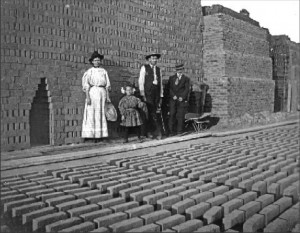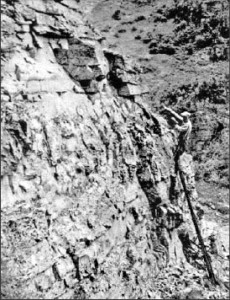By James E. Fell, Jr.
Published in 2009 by University Press of Colorado
ISBN 978-0-87081-946-9
Reviewed by Virginia McConnell Simmons
Like most readers in Colorado, I have countless books and booklets about the holes in the ground where miners struck it rich or suffered disappointment, but until I read this book, I never knew much about the rusty smelter ruins and grimy slag heaps that remain near those mines. The no-nonsense tome Ores to Metals became a lodestone for me this summer, attracting me to read every page and learn the things about the smelter ruins and slag heaps that have been ignored in the more popular dramas and melodramas about mining.
Lacking knowledge about chemistry or mineralogy, some readers may be averse to a book about smelters, but this one fills a need for serious students of Colorado history and for more casual readers who want to know more than the familiar stories about prospectors at Cherry Creek, South Park, and California Gulch. In understandable language, Ores to Metals discusses the smelter industry, the industrialists, investors, and technologies that the mining industry depended upon after the gravel bars played out.
As an example of the information in this volume, a reader will learn that the move of early smelters, reduction works and refineries from the mountains to Denver and Pueblo in the 1870s resulted from environmental needs as well as from economic advantages. At Black Hawk, author James Fell points out, space was inadequate for expansion, while human health suffered from smoke and fumes that were choking the cramped valley. Fuel had become inadequate, as mountains slopes were denuded of trees for charcoal and construction. The federal government brought suit against the Boston and Colorado Company because of removal of timber from public land, but the company offered the defense that the timber was being cut legally on mining claims.
Perhaps more important, construction of railroads made it more practicable to move down to the open, cheap land on the Front Range, where trains could conveniently deliver coal, a better fuel, from around Trinidad and Cañon City instead of hauling it uphill to smelters. Meanwhile, ore could be rolled downhill by rail to Denver and Pueblo for smelting and from there to Omaha or St. Louis for refining. Here, buffs can learn much about the unromantic functions of railroading in mining and smelting country.
The era of smelting in Denver and Pueblo lasted only a few decades, but in those years, Colorado’s early industrialists, investors, and millionaires became familiar names. The leading cast included Nathaniel Hill, James B. Grant, Meyer Guggenheim and his stable of sons, Anton Eilers and many others who were involved at places like Argo, Globeville and Blende. Fell shows the development of their different processes that were suitable for their different ores, the competition in purchasing ores from mining companies, and the necessity of accessing other minerals from Utah, Montana, Mexico, even Australia, for use in reduction.
Here in Central Colorado, smelting at Leadville is probably more familiar. Fell’s book discusses the Harrison Reduction Works, and, of course, the Arkansas Valley Smelting operation gets plenty of attention, appropriately. Small operations at places like Alma, Dudley, Mount Bross, St. Elmo, Monarch, and Aspen also are included. On the Western Slope, the role of Durango’s smelter in San Juan mining is discussed, but I regretted that Creede received little attention, and Summitville none. Of special interest to Salida’s readers will be the history of the Ohio and Colorado Smelting Company. It erected the big smokestack on the mesa northeast of town and employed 250 workers at one point in its life between 1902 and 1920.
A name that is well-known to most today is ASARCO, the giant American Mining and Smelting Company that followed earlier attempts to organize combines. Fell gives the story of the formation of this smelting trust that was designed to increase the efficiency of participating corporations and to decrease their costs and competition.
A reprint of its highly praised first edition, published in 1979, Ores to Metals is a book that belongs on the shelf of all readers who want to understand how Colorado matured so rapidly from rambunctious youth to conventional adulthood.


